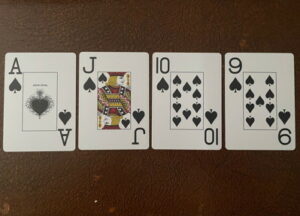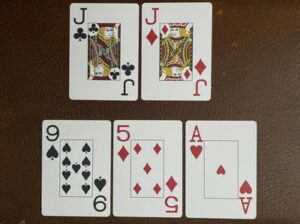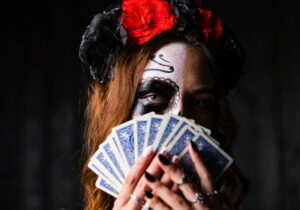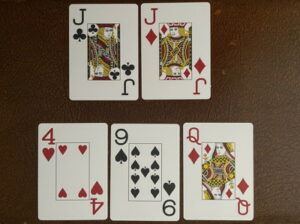 When we talk about what is scary about poker, we can all agree that there is nothing more scary than a good scare card on the river. So, what exactly is a scare card and what makes up a scary board in poker?
When we talk about what is scary about poker, we can all agree that there is nothing more scary than a good scare card on the river. So, what exactly is a scare card and what makes up a scary board in poker?
It sounds kind of obvious, but a scary board is a board that is scary. What this means is that the board has several draws and possible outcomes making things highly unpredictable. Let’s say the board is A / J / T / 9 with four spades. This would be a scary board. And on a scary board, players will often rightly be wary.
In this scenario, it is entirely possible that one or more players could put together a straight, two pair, a flush, a three of a kind, etc. Naturally then, a scary board is even more frightening if there are a higher number of players in the hand.
Beware Of The Scary Cards
 A scary card can make a normal board into a scary one. Scare cards are community cards that are perceived to have made a strong hand for an opponent and so scares the other players in the hand. Because of this players tend to play passively and check their hand rather than betting.
A scary card can make a normal board into a scary one. Scare cards are community cards that are perceived to have made a strong hand for an opponent and so scares the other players in the hand. Because of this players tend to play passively and check their hand rather than betting.
If you are holding J / J and the flop comes A / 5 / 9, then the ace is a scare card because your opponents will have a lot of A x hands within their pre flop ranges. Essentially, a scare card is a card that fundamentally alters the strength of your range, your opponent’s range or even both players’ ranges.
Another example would be if we had a flop of 7 / T / J with two spades. Here, the board offers a number of draws. Then the turn delivers an 8S to turn this dynamic flop into a scary board. With the eight of spades, your opponent might have several possible two pair combinations. They could have could have several straights or they could have a flush. Therefore, a scary card is simply a card that makes the board scary where the possibilities are huge.
The overall idea behind scare cards is that they make the board more frightening to our holding. However, it’s important to remember that a scare card that hasn’t improved our opponent’s hand, is every bit as scary to them as it is to us.
On one hand, when a player bets on a scary board or a scary card, you have to give them credit. On the other hand, though, a scary board or a scary card can provide a great opportunity for a bluff. If you bluff with a scary card and your opponent has nothing, they will often simply fold.
Mastering Scare Cards In Poker
 One of the best ways we can improve and get better at poker is to find where we can carry on playing aggressively and force other people to fold regardless of the cards of what cards we are holding. Most players have learned about continuation betting on the flop and simply make a regular bet after seeing a flop regardless.
One of the best ways we can improve and get better at poker is to find where we can carry on playing aggressively and force other people to fold regardless of the cards of what cards we are holding. Most players have learned about continuation betting on the flop and simply make a regular bet after seeing a flop regardless.
However, if we bet on a lot of flops and then muck all of the turns where our hand isn’t very strong, we will end up conceding numerous pots that we would have had a chance of winning with a second bet.
A good example of where we can maintain our aggression on the turn is when that turn card is an over card to the rest of the board. An ace on the turn is the ultimate scare card, but a king or queen on the turn can also work as well.
A lot of turn double barrel bets when an over card comes are going to be semi bluffs, but they don’t always have to be. We can just as effectively make the exact same move if we are, say, holding pocket fours, where we have most certainly behind our opponent, and we have very little equity in the hand. But that turn over card will still hit pretty heavy.
Another good thing about using the turn over card to your benefit is growing your win rate with hands that many players consider to be trouble hands. Take a hand like queen – jack which is a archetypal trouble hand that causes a lot of bad poker players limp on with, maybe calling a raise from a tight opponent before putting way too much money into the pot with a top pair only to lose the hand with a mediocre kicker.
We now have a battle plan of attack to play queen – jack differently. Taking into consideration our position, table image and other table conditions, if we consider the hand worth playing, we will bring it in for a raise.
Lets say we raise with queen – jack suited and get called. The flop brings 7S / 8H / 2C and we then decide that we will get enough folds if we C-bet here which we do but then our villain calls. As soon as they have called, we can begin thinking about our chances to double barrel. Here, we will be able to double barrel with any ace or any king on the turn.
Either a nine or ten will give us a gut shot to the nut straight and any other card of the same suit will give us our backdoor flush draw. That means that 21 cards out of 47 will allow us to keep playing aggressively while only holding queen high.
What Are Over Cards And Under Cards In Poker?
 You might have picked up on terms such as over cards and under cards further up the page. For those that don’t already know, the difference between over cards and under cards is that over cards are cards higher than any other card or pair.
You might have picked up on terms such as over cards and under cards further up the page. For those that don’t already know, the difference between over cards and under cards is that over cards are cards higher than any other card or pair.
The term is used in direct reference to the community cards in a game of Texas hold ’em while an under card is a card lower than another given card or pair. Under cards are cards that are ranked lower than another given card or pair. So, an eight on the turn would be an under card to a pair of nines for example.
The term over card is usually used to refer to a community card that is ranked higher than a player’s pocket pair. For example, if you are holding J J and the flop delivers Q / 9 / 4, the flop has one over card to your pair which, naturally, is the queen. The term can also be applied to hole cards that rank higher than any card appearing on the board as well. For example, let’s say that you have been dealt A K and the flop comes Q / 9 / 4. You might not have a pair, but you do still have two over cards to the board.
Using turn over cards to your advantage can help take you from thinking like a standard poker player, thinking only about your own cards, to a far more complex player where your main concern is what your opponent suspects that you might be holding. Your default play when an ace or a king land on the turn is to consider betting for a second time regardless of whether or not you have that card.
